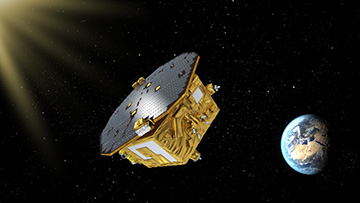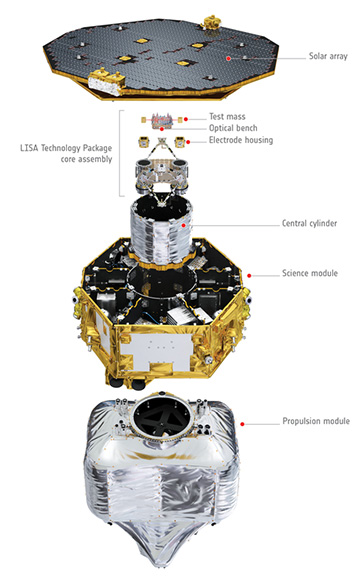
Artist’s rendering of LISA Pathfinder spacecraft at Lagrange Point 1. [Image: ESA–C.Carreau]
In what’s been described as “a tour de force in precision measurement,” a consortium of European scientists reports that a key component of a proposed future space-based gravitational-wave detector, the planned Laser Interferometer Space Antenna (LISA), has passed its first important technical test with flying colors (Phys. Rev. Lett., doi: 10.1103/PhysRevLett.116.231101).
The report constitutes the first technical result of the LISA Pathfinder mission of the European Space Agency (ESA). LISA Pathfinder was launched in December 2015 as a trial run of core LISA technology, to establish whether the unusual and extreme sensitivity requirements of such a space-based gravitational-wave observatory could actually be achieved. The initial results from the spacecraft appear to answer that question with an unequivocal yes.
The accomplishment, according to the study's authors, marks “a major step forward” in demonstrating the future mission’s feasibility—and, thus, in developing a next-generation gravitational-wave platform capable of shedding light on some of the most massive astrophysical events in the cosmos.
Longer waves, bigger events
The announcement earlier this year of the first detection of gravitational waves by the Earth-based Laser Interferometer Gravitational-Wave Observatory (LIGO) was widely viewed as heralding a new era of “gravitational-wave astronomy,” opening a previously unavailable window on exotic events like the merger of astrophysical black holes. But even the exquisitely sensitive LIGO has its limitations. In particular, its 4-km-long interferometer arms are far too short to pick up the expected gravitational-wave signature of the Universe’s most monumental events, such as the merger of supermassive black holes.
Such events, thought to hold a key to unlocking mysteries of galaxy formation and to undertaking certain tests of general relativity, have an expected gravitational-wave frequency on the order of 1 mHz to 1 Hz. Detecting them will require an interferometer with arms on the order of a million km in length, and freedom from low-frequency gravitational noise sources on Earth—both conditions feasible only in space.
Ambitious project
ESA’s ambitious LISA mission, proposed for deployment in 2034, would cover that low-frequency gravitational-wave band by using three satellites to create a sort of giant LIGO in space. Under the proposal, three LISA spacecraft would be set up at the vertices a large equilateral triangle in space, roughly a million km on each side. In a setup analogous to the Earth-based LIGO, each spacecraft would contain two exquisitely machined gold-platinum test masses. Laser beams bounced back and forth between test masses on the three widely dispersed spacecraft would be used to measure changes in the distance between them (via interferometry).
Those changes, as with LIGO, would be used to infer the presence of gravitational waves. And, also as with LIGO, the length changes signaling those waves would be almost inconceivably small—on the order of 10–11 m across a million-km span.
Not surprisingly, measuring such tiny changes across so broad a span of space carries some unusual, and daunting, technical requirements. Most important: for the system to work, the test masses in each of the three LISA spacecraft must be in a state of virtually perfect free fall. They also need to be protected from even the minutest sources of force noise—ranging from tiny gravitational-field gradients attributable to spacecraft motion, to radiation pressure from solar photons—that could jiggle the masses enough to swamp the tiny gravitational-wave signal. To provide the requisite protection, each LISA spacecraft thus will float around the free-falling test masses within it, and will include a variety of thrusters, sensors, and servo mechanisms to keep the spacecraft’s motion from interfering with the free fall of the test masses.

Exploded view of LISA Pathfinder. Two test masses are separated by an optical bench interferometer used to measure the masses’ residual acceleration with respect to one another over a period of days to weeks. The measurements allowed the researchers to test how well the prototype spacecraft systems protected the test masses from sources of force noise in space. [Image: ESA/ATG medialab]
Auspicious test
The LISA Pathfinder mission was sent aloft to test whether the proposed LISA system, as designed, can actually meet its exquisite free-fall requirements. LISA Pathfinder consists of only one spacecraft, not three, positioned at Lagrange Point 1, a gravitationally neutral point between the Earth and the Sun. The spacecraft, like the proposed ones that would form the vertices of the LISA triangle, contains two test masses, separated within the spacecraft by less than a meter. That's far too short a spacing to pick up any kind of gravitational wave. But it’s an ample distance for testing the relative time-dependent displacement of the two test masses (through laser heterodyne interferometry and other techniques) over periods of days to weeks, and thereby assessing the possible impacts of force noise sources on their state of free fall.
The results of the mission thus far, in eleven test runs carried out in spring 2016, have proved auspicious for the future LISA undertaking. The team found that, over the frequency ranges that would be important to the proposed LISA mission, the relative motion of the two test masses in the spacecraft suggest residual accelerations due to external noise sources of less than half a femto-g.
In other words, the two reference masses in the test spacecraft showed relative accelerations of less than one half of a millionth of a billionth of Earth’s gravitational acceleration. That is as close to true free fall as any human-created object has ever experienced. It also beats the LISA maximum-noise requirement by more than a factor of five.
LIGO Executive Director and OSA Fellow David Reitze, in a commentary accompanying the new study, called the results “a tour de force in precision measurement,” and noted that they “bode extremely well for the future LISA mission.”
